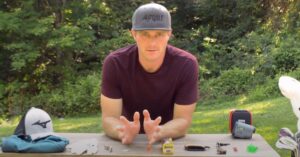What Is A Golf Divot? Essential Tips for Repairing Your Game
Golf can be a game of precision, but every golfer knows that swings don’t always go as planned. One moment you’re aiming for the fairway, and the next, you’ve created a small patch of chaos in the grass.
A golf divot refers to the chunk of turf displaced during an improper swing. It happens when your club strikes the ground instead of just hitting the ball. This seemingly minor detail can have significant impacts on both your game and course maintenance.
Curious about how divots affect play or what you should do after making one? Stay tuned for essential tips on managing these pesky patches while safeguarding our greens.
What Is a Golf Divot? Definition and Common Misconceptions
The term “golf divot” often sparks curiosity among both new and seasoned players. Understanding what it is can transform your approach to the game.
A golf divot is essentially a piece of grass that gets removed from the ground when a club hits the turf instead of just making contact with the ball.
This action creates an impression in the earth, which can impact how well your shot performs next time. Many believe that divots are simply signs of poor technique, but there’s more to this story.
One common misconception is that divots only occur during drives or full swings. In reality, they can happen at any point in your game, even on short chips or putts if you catch them wrong.
Another myth suggests that all divots damage the course significantly; however, not all courses treat every type of divot equally. For example, temporary par-3 holes might have different guidelines for repair than lush fairways.
“A proper understanding of repair techniques helps maintain course quality while ensuring enjoyable play.” – Jerry Henson, Golf Course Superintendent
You might ask: why should I care about my divots? The answer lies in their impact on playability and conditions for fellow golfers. When left unrepaired, these patches can lead to uneven surfaces and hinder other players’ shots.
It’s also worth noting that some golfers think larger divots mean better club performance; however, that’s not accurate either! Consistent swing technique focuses more on timing rather than size. Experts emphasize maintaining good rhythm over infrequent large removals from grass coverage.
5 Key Causes of Golf Divots and How to Prevent Them
Understanding the key causes of golf divots can significantly improve your game. Many golfers experience this frustrating issue, often without realizing why it happens. Let’s take a closer look at some common culprits.
Poor Swing Technique
The most frequent cause of a divot is an improper swing technique. When players rush their swings or have inconsistent follow-throughs, they tend to strike the ground before hitting the ball.
A study by the PGA revealed that over 70% of amateur golfers struggle with their swing tempo. Maintaining smooth rhythm and balance throughout your swing can help prevent unwanted divots.
Incorrect Club Selection
Choosing the wrong club for specific shots is another significant factor in creating divots. Using clubs that are not suited for distance or terrain can lead to incorrect contact with the ground.
For instance, using a driver on a tight lie may increase your chances of making impact with turf instead of just striking the ball. Always assess the situation before selecting your club!
Over-the-Top Swing Path
An over-the-top swing path occurs when you come down too steeply during your downswing. This leads to digging into the ground rather than sweeping through it.
“Avoiding an over-the-top move allows for better contact and less chance for turf.” – Mark Wilson, Golf Pro
Lack of Course Awareness
Your surroundings play a vital role in preventing divots as well. Hitting from uneven surfaces or in wet conditions increases potential damage to grass.
- Check grass height before swinging; longer grass increases risk.
- Avoid playing after heavy rain unless absolutely necessary.
- If possible, avoid hitting off mats where you cannot gauge ground conditions accurately.
Tired Muscles and Fatigue
An overlooked reason behind many erratic swings is fatigue. As muscles tire toward end-of-round play, tension builds up which negatively affects mechanics.
| Cause | Prevention Strategy |
|---|---|
| Poor Swing Technique | Focus on developing consistent rhythm and timing during practice sessions. |
| Incorrect Club Selection | Evaluate course conditions thoroughly before each shot choice based on distance needed & surface type available. |
Expert Techniques for Repairing Golf Divots on the Course

Repairing a golf divot is not just about restoring the turf. It’s an act that shows respect for the game and fellow players. Knowing how to fix a divot properly can enhance your playing experience while keeping courses in top shape.
The Importance of Timely Repairs
Every golfer creates divots; it’s part of the sport. However, repairing them promptly matters greatly. Unattended divots can create uneven surfaces, making play difficult for others.
A study by the USGA indicates that unrepaired divots can take twice as long to recover compared to those fixed immediately.
“A small effort from each player leads to big improvements in course conditions.” – Tom Johnson, Turf Management Expert
Steps for Effective Divot Repair
Here are simple yet effective techniques that anyone can follow:
- Picking Up Debris: After taking your shot, retrieve any dislodged grass or soil fragments nearby if you caused a significant chunk.
- Using a Divot Tool: Carry a proper divot tool with you at all times. Gently lift up edges of the remaining grass around the hole towards its center using this tool.
- Tamping Down: Once you’ve repositioned loose grass over the exposed soil, use your foot or club heel gently to tamp it down into place.
- Sowing Grass Seed (if permitted): In some locations, adding seed after repair promotes quicker regrowth. Make sure any seeds used align with local grasses on your course.
Your Role in Course Maintenance
You play an essential role in maintaining golf courses whenever you repair your own divots correctly. Remember: proper etiquette involves helping sustain consistency across greens and fairways.
| Technique | Benefits |
|---|---|
| Timely Repairing & Tamping Down | Prevents further damage and encourages healthy growth of replacement turf. |
| Adding Grass Seed (where allowed) | Promotes recovery and reduces visibility of past damage quickly during playtime. |
Caring for our shared spaces fosters camaraderie among golfers while boosting overall enjoyment on every round played!
FAQs
How do divots impact my golf game?
A golf divot can disrupt your swing and affect shot accuracy. Leaving divots unrepaired leads to uneven turf, making it harder for you and others to play effectively on the course.
What should I do if I create a divot?
If you create a divot, repair it immediately using proper techniques. Pick up any displaced grass, use a divot tool to reshape the area, and tamp it down gently for quicker recovery.
Can all golfers prevent creating divots?
Most golfers can reduce their chances of making divots by improving technique. Focus on smooth swings, correct club selection, and being mindful of ground conditions during play to minimize damage.






![How Not to Shank the Golf Ball? [Try These Tips And Tricks] how-not-to-shank-the-golf-ball](https://giftedgolfers.com/wp-content/uploads/2023/05/how-not-to-shank-the-golf-ball-300x157.jpg)